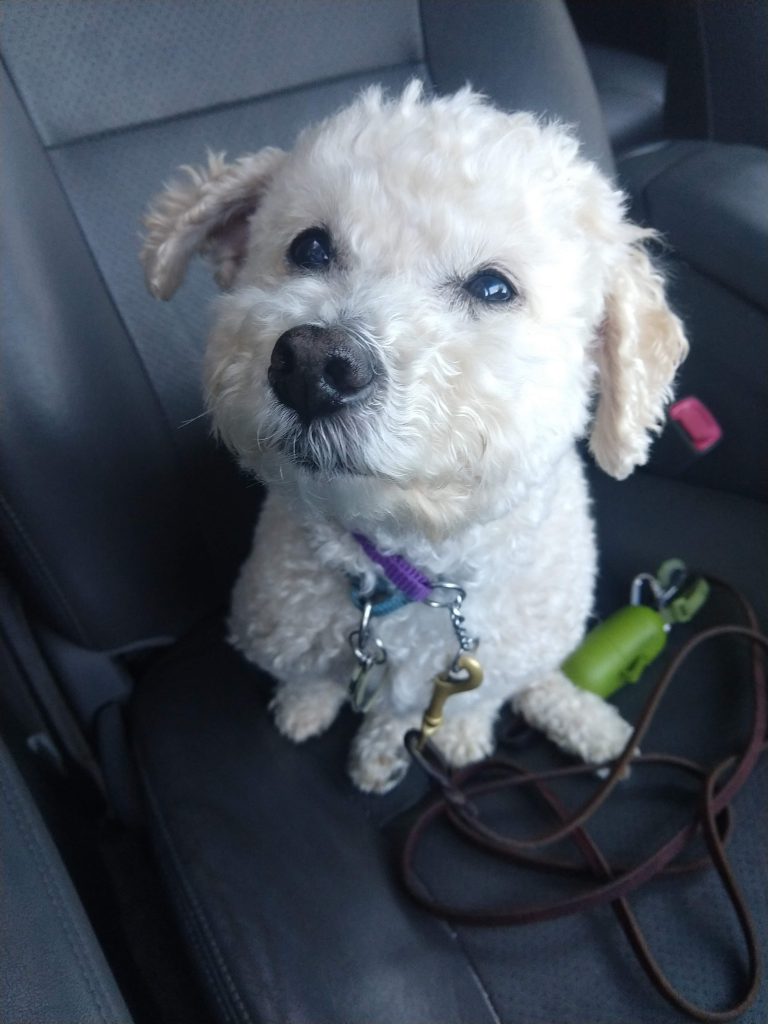Happy 2020!
At the beginning of the new year, we always go for our routine walk in the neighborhood because Agent B (my dog Bailey) always needs to secure his territories in the new year. This morning, as Bailey busy sniffing and marking at some flower bushes on the sidewalk, we heard a loud squeak of a tire skidding to an emergency stop. Took us by surprise, an off-leash dog ran across the street to come sniff Bailey without noticing the oncoming car on the street! Luckily, the driver saw the off-leash dog and stopped the car in time or this would have ended terribly. There was no injury to anyone except everyone at the scene probably experienced unnecessary adrenaline rush!
The dog is a neighborhood dog who Bailey had met a few times previously. The owners and the dog just came back from somewhere. As the owners were parking the car on their driveway and getting out of the car, this dog saw Bailey, his friend, and dashed to get across street to say hi. The owner didn’t have time to even put the leash on the dog nor call the dog back. Everything happened so fast! I am thankful the car driver was careful with the street condition and the break on the car worked!
If the dog had a solid WAIT, it would have saved everyone from the scary heart attack. This shows how important WAIT is for your dog’s safety and it is a critical life-saving behavior to teach your dog.

It is always a good idea to ask your dog to pause at any threshold whether it is physical one like a door way or invisible one such as a car door or curbside. Self/Impulse control and handler-focus are other two key foundations when teaching WAIT.
So, what is WAIT? WAIT basically means “stop forward motion”. If I tell my dog WAIT, I expect him to pause his forward motion and stay at the location. I don’t need him to SIT or DOWN or even LOOK AT ME. I just need him to wait for me there.
Here are some steps to start training WAIT:
- Manage the environment and your dog. This means, you don’t open door unless you have a good control on your dog. You can also make sure your dog is properly/safely leashed up before you open the door. Baby gate or x-pen is an excellent security tool to ensure your dog can’t just bolt out of the door before he has a solid WAIT.
- Practice “handler-focus”. If your dog thinks you are the most interesting thing in the world, it reduces the chance your dog rushes to get to something else. The incident I mentioned above, the off-leash dog was eager to see his friend and totally forgot about his people and the potential danger of the street. If he had a good handler-focus, he would have waited for his person to tell him what to do without bolting out he door. To encourage and develop “handler-focus”, find out what your dog finds rewarding (food, toys, freedom, safety, attention, etc.) and use that to build the focus on you in all situations.
- Practice “self-control”. This goes hand-in-hand with “handler-focus”. If your dog has a solid “handler-focus” and can ignore distractions/triggers because he has a good self-control, you will have enough time to get your dog away from danger. To develop self control, I often start with teaching “ItsYerChoice” game developed by Susan Garrett. When your dog understands how to make a good choice, he will have better self-control and impulse-control. A good self-control would be super important if you have a high prey drive dog.
- Make the waiting location valuable. Whether you say “wait” or use your hand cue to signal your dog to pause, you want your dog simply stop and just waits for you on the spot. Mark when he stops his forward motion and reward lavishly on the spot. You want him to understand “waiting for you on the spot” is the most rewarding thing in the world. If you are using a doorway to train WAIT, make sure you reward your dog at the location he waits not when he crosses over the line. Note: make sure you deliver cookie to him so he doesn’t need to approach you and cross the line for the cookie.
- Add in (mild) distraction. Once your dog has a good handler-focus and self-control, while your dog’s on leash or behind a baby gate, add in a boring distraction such as a toy. Let your dog see the toy and say your WAIT. If your dog doesn’t dash to get to the toy, mark and reward him for staying by your side. Slowly build up your dog’s self-control toward more interesting distractions. If you have a dog who chases squirrels, you do not want a real squirrel taunting your dog during your first training session!
- Generalize this behavior and practice everywhere. Bring WAIT to the real world and practice whenever you see opportunities. You can ask your dog to wait when you are locking the door before heading out for walk. You can ask your dog wait inside the car before you let him jump out. You can ask your dog to wait just because. 🙂
I hope you will make teaching “WAIT” your dog’s new year resolution!
Happy Training~
